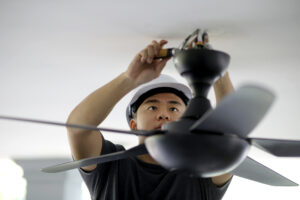Get Your Ceiling Fan Questions Answered by Your Local Electric Company
There’s a strong possibility that if you look up from where you are reading this, you will notice a ceiling fan above you. Many homeowners don’t think much about these little appliances until they break down. We have put together a list of responses to some frequently asked questions to assist you in better understanding how to recognize and fix problems with your ceiling fan.
Remember that you can contact Sonner Electric for help with residential electric issues including ceiling fan installation. Contact us at 661-728-0126 for help.
Why is my ceiling fan humming?
If your fan is buzzing, the motor’s vibration is probably to blame. However, other potential causes for this include faulty wiring, loosened fasteners, or the need to grease the fan’s motor. A simple hum will typically not be alarming and can be disregarded. Sonner Electric will be happy to examine your fan and provide professional advice regarding repairing or replacing the item if you’ve observed the noise increasing louder.
Why does my ceiling fan shake when it’s on?
A loose connection between the fan and the ceiling, which results in an uneven spin, is the most frequent reason of a shaky fan. Uneven blades, which result in uneven weight distribution, are another frequent cause. The motor of your fan may be damaged by uneven blades, which may cause it to wear out earlier than it should. Keep your blades clean because even a small amount of dust accumulation might harm them.
If my ceiling fan breaks, do I need to get a new one?
No, not always. Check to see if the lights and outlets around are still receiving electricity if your fan isn’t functioning. If you want to know if the circuit breaker has tripped, check your electrical panel. When your fan stops working despite everything being in order, it’s time to arrange for a repair or replacement. If necessary, Sonner Electric can install a new fan for you after helping you identify the issue.
Why does my light work but my ceiling fan does not?
If the light on your ceiling fan is still on but the fan isn’t, the motor most likely has to be replaced. You shouldn’t attempt a process like that on your own and instead seek the help of a certified electrician to ensure that your motor is replaced correctly.
Is it dangerous that my ceiling fan keeps tripping the breaker?
There is a good likelihood that you have major wiring problems, such as a short circuit or a ground fault, if your fan continually tripping the circuit breaker. Because the problem might be a short circuit, you should consult an electrical service specialist right once. Short circuits shouldn’t be left ignored because they can result in fire, electrocution, or electrical burns.
In the summer and winter, which way should a fan be turned?
For your home to be at its ideal temperature, you should turn your fan counterclockwise in the summer and clockwise in the winter. A counterclockwise fan will provide a downdraft, preventing heated air from becoming stagnant and cool air from rising. On the other hand, a fan that spins counterclockwise will draw air upward and maintain a comfortable temperature in your space.
Can my ceiling fan have lights added?
You may add light kits to existing ceiling fans, so you won’t need to replace your entire unit if your ceiling fan lacks lights. Lighting kits for existing fans are widely available at home improvement stores, but electrical work is always best carried out by qualified professionals.
Call us with your additional questions
Sonner Electric can provide answers to any more questions you may have regarding your ceiling fan or other electrical appliances in your home. If the solution to your query entails changing a fan or mounting a light kit, we can handle it for you. Call us at Sonner Electric to schedule an appointment.


